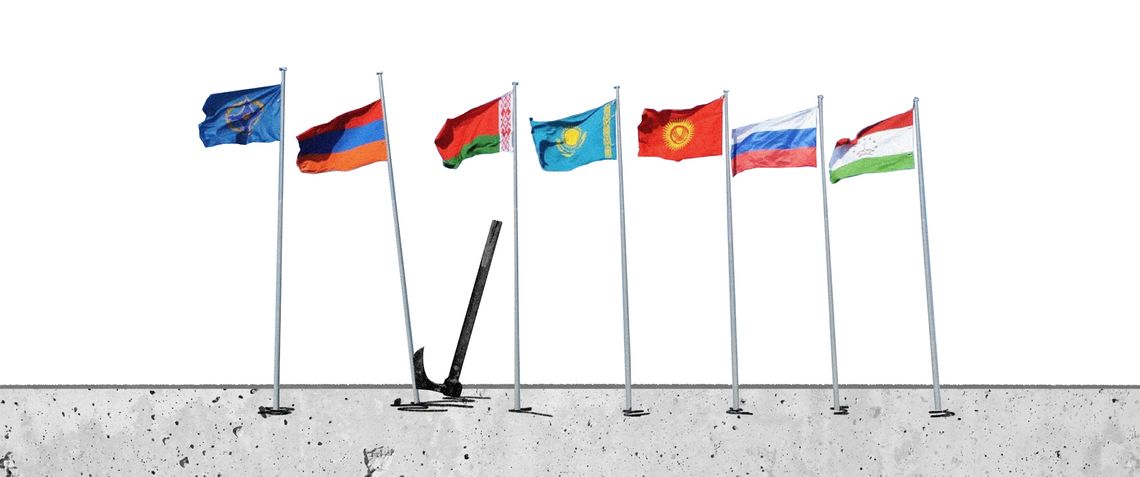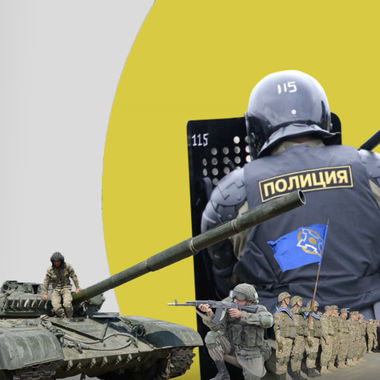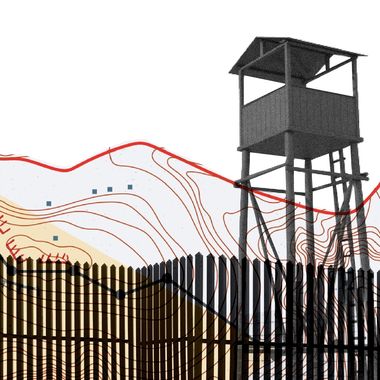
Illustration by Armine Shahbazyan.
On September 16, 2021, Armenia took on the chairmanship of the Collective Security Treaty Organization (CSTO), the strategic military alliance that unites Armenia, Russia, Belarus, Kazakhstan, Kyrgyzstan and Tajikistan. The new responsibility comes at a pivotal time.
In the midst of the 2020 Artsakh War, Azerbaijan attacked positions within the Republic of Armenia on October 14, 2020. The lack of a response from the CSTO cast into doubt whether the organization was capable of fulfilling its primary objective—ensuring collective security. Whereas Russia had previously made clear that its guarantees of assistance did not cover Artsakh [when Armenia became a CSTO member, it had to accept a provision that its membership only covered its UN-recognized borders], Article 4 of the CSTO Charter should unambiguously bind member states to provide their ally with military support if an attack takes place. However, some CSTO members actively supported Azerbaijan during and after the 2020 Artsakh War. Belarus supplied Azerbaijan with Polonez missiles during the war. Kazakhstan’s Minister of Foreign Affairs Mukhtar Tleuberdi congratulated Azerbaijan on the restoration of its territorial integrity during his visit to Baku in June 2021.
In May 2021, Azerbaijan began incursions across the Armenian border, positioning its troops on the territory of the Republic of Armenia. Again, the CSTO sat idle, calling it a border demarcation issue. Collective actions are not being taken by the group when it comes to the national interests of Armenia, raising concerning questions for Yerevan. Armenia requested that the CSTO activate the mechanism of emergency consultations on May 14. Viktor Biyagov, Armenia’s Representative to the CSTO, informed the organization about the escalation at the Armenian-Azerbaijani border. However, CSTO members took a neutral position and continued to sow doubt in Armenia as to why we are a member at all. On May 26, the Armenian government formally expressed its dissatisfaction with the bloc’s response. By exploring the possibility of applying to the UN Security Council if the collective efforts of the CSTO and the unified group of Armenian-Russian forces proved not be enough for the resolution of the escalation, Yerevan tried to push the CSTO into action. It worked. On the same day, the CSTO expressed its readiness to start consultations on the escalation at the Armenian-Azerbaijani border, which it had received on May 14. The activation of the CSTO consultations still did not deter further attacks. Escalations in Syunik, Gegharkunik and Ararat regions are still ongoing. No rapid preventive response from the CSTO ever came to pass.
While Baku’s attacks at Black Lake, Verin Shorzha and Yeraskh continue, its origins lie in the bellicose rhetoric of Ilham Aliyev, when he announced at the special congress of his New Azerbaijan Party in March 2021 that, if needed, Azerbaijan will force Armenia to open a “Zangezur corridor” by force. Taking advantage of Yerevan’s weak post-war position, Baku tried to keep up the pressure. The July round of attacks were a new challenge for the CSTO. The organization characterized the new cycle of escalation as a border incident. An official statement only appeared at the end of July, when Secretary General of the CSTO Stanislav Zas (from Belarus) expressed a neutral position. Russia, which has taken a more active role separately from the CSTO, also connects the cross-border fire with delimitation and demarcation, despite the fact that Yeraskh is not a new border region.
Moscow understands the significance of Armenia. Turkey is actively engaged in regional processes, including the opening of a “Zangezur corridor’’, reiterated in the Shushi Declaration. While the opening of communications through Meghri plays into the hands of Moscow, an actual land corridor would not be in the geopolitical interests of Russia. It would allow Azerbaijan to refuse the extension of the mandate of the Russian peacekeepers in Artsakh and potentially displace the remaining Armenian population.
It is clear to Moscow that it should remain neutral for as long as possible. And so, it plays a double game. It doesn’t hinder Azerbaijani aggression either individually or collectively (through the CSTO), while it takes the opportunity to increase its military presence in Armenia. Russian military experts are actively engaged in the modernization of the Armenian Army.
The visit of Stanislav Zas to Armenia in August demonstrated a turnaround in trying to engage better with Armenia. However, the indifference of CSTO member states toward the escalation that started in May (from Tajikistan, Kyrgyzstan, Kazakhstan, Belarus and Russia) will be difficult to overcome. Though not related to CSTO actions, Belarus delivered another blow when President Alexander Lukashenko announced that peace in Artsakh had been achieved thanks to Baku.
Bilateral relations between Baku and CSTO member states are on a higher level than Armenia has been able to forge. For example, Azerbaijan is a transitional route for Kazakhstan in transporting its goods to Turkey and Europe. Belarus is an arms supplier to Azerbaijan. Both of them have taken Azerbaijan’s side over the past year.
Ultimately, the CSTO is meant as a counterbalance to NATO, a tool for Russia to secure its “Near Abroad” from joining the Western camp, but is not capable of solving issues within the post-Soviet space. Both the Armenia-Azerbaijan and Kyrgyzstan-Tajikistan conflicts have been left to languish.
In continuing his attacks, Azerbaijani President Ilham Aliyev is pursuing short- and long-term objectives. The first is to force a peace treaty upon Armenia as soon as possible. Armenia is temporarily in a weak position and time will only erode Azerbaijan’s advantages. The EU’s financial support to Armenia and the engagement of Russian military experts in the restoration and modernization of the Armenian Army are real challenges for Azerbaijan. A stronger Armenia means a stronger negotiator.
The second is to gain access to Nakhichevan through Meghri, securing optimal conditions for Azerbaijan. Baku, alongside Ankara, is trying to force Yerevan into a corner and extract concessions. A longer term objective of Azerbaijan is to diminish Russia’s role in the region. The Azerbaijani-Turkish tandem creates a new reality in the region. Events like the Shushi Declaration, which insists on the opening of a ‘’corridor’’, is a logical continuation of replacing Russia’s role with Turkey. First of all, the Azerbaijani public is not fully satisfied with the result of the 2020 Artsakh War because Artsakh itself (except for the Hadrut and Shushi regions) remains beyond the control of Baku. Secondly, the concept of pan-Turanism envisions a new power that is not subject to Russian diktats.
The Azerbaijani-Turkish tandem wants to get ahead of Russia in the supply of hydrocarbons to Europe. Therefore, the unblocking of communications is a direct threat to Russia’s energy strategy of market dominance.
The Russian-led CSTO clearly understands the explosive potential of the region. However, a balanced strategy can’t last long. On the one hand, Armenia will not be able to tolerate continued indifference to attacks against its territory. On the other hand, Azerbaijan continues to undermine Russian influence and give Turkey reach into Central Asia.
Even Russia’s individual approach, separate from the CSTO, needs to expand beyond the militarization of Armenia to also include diplomatic support for its ally. France has taken a much more pro-Armenian position on the international stage. Kyrgyzstan and Tajikistan may be next in exploring additional options for guaranteeing their security.
Armenia will be looking to take advantage of its chairmanship of the CSTO to create a new Crisis Response Center. If its supposed allies continue their indifference even at the organizational stage, they should all be asking themselves why they are together in the first place.
Also see
Fact Sheet: What is the Collective Security Treaty Organization?
By Karena Avedissian
This Fact Sheet about the Collective Security Treaty Organization is part of a larger project, “Understanding the Region: The Caucasus and Beyond.” It explains what the purpose of the military alliance is, what membership entails, its weaknesses and more.
Armenia’s New Security Architecture: Russia as Geopolitical Bodyguard
By Nerses Kopalyan
Armenia needs to reconfigure the political economy of its security architecture by utilizing its security alliance with Russia, through a mechanism of burden-sharing, where Russia’s geopolitical interests are aligned with Armenia’s security interests.
Russia’s Increasing Military Presence in Armenia
By Hovhannes Nazaretyan
When Armenia declared independence in 1991, there was still a large contingent of Soviet troops in the country. Russian military presence, however, stretches back to the early 19th century and now, after the 2020 Artsakh War, is expanding.
Russia’s Partnership With Turkey and What It Means for Armenia
By Zaven Sargsian
Many assumed that Turkey’s direct involvement in the 2020 Artsakh War and thereby its intrusion into Russia’s “near abroad” would be met with hostility by Russia, or at least vocal condemnation. The reaction was mild, writes Zaven Sargsian.
Geography is Inescapable
By Artin DerSimonian
Following Moscow’s facilitation of the ceasefire agreement ending the 2020 Artsakh War, some are asking whether Armenia should pursue “more Russia or less Russia.” The reality of the matter is that geography is inescapable.
Comments
Anahid Karaguesian
9/23/2021, 11:20:10 PMThis is a wonderful article. Thank you, EVNREPORT. Read between the lines, and it's clear that the author is saying that Russia betrayed Armenians last year and is continuing to do so. He is absolutely correct. Moreover, such betrayal is not even in Russia's interest. It is strange that very few Armenians are not stating these obvious things. Thq question is, why not?








